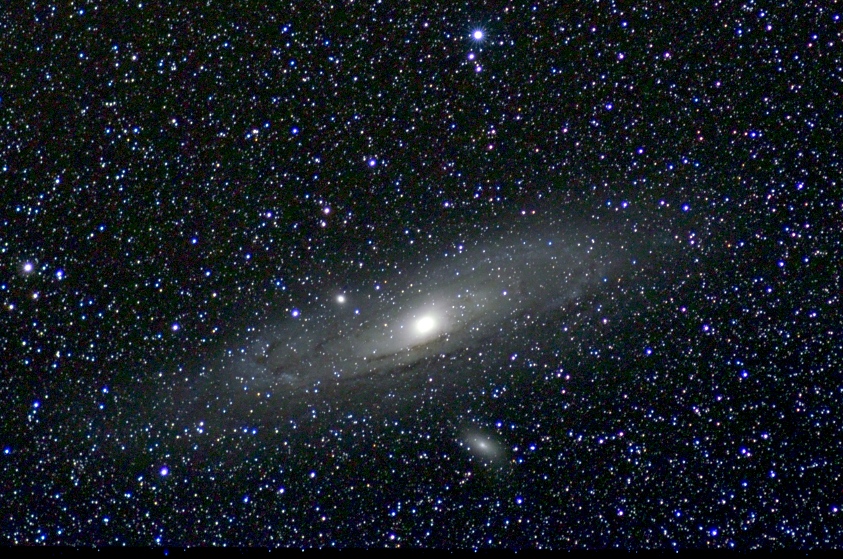This software is gpl-licensed. I really think something simple and gpl-ed is needed around stacking astro-photo, so here is my attempt !
beta-testers are needed, please report ; I'd also be glad to test on some stacks of yours with newer challenges in it, I don't have enough time to collect enough interesting samples by myself.
Jean-Daniel Pauget - mail : exposit(please-turn-this-to-arobas)disjunkt.com

The best source is probably either the git repository or its github mirror.
Notes for installing / testing exposit
- early-beta-0.02
at this stage exposit can
- take a list of jpg to be processed (from the command line only)
- take a reference jpg for correcting fall-off (or related aberations)
(command-line only)
- propose an initial noise-cut and gain in order to reveal nebulous objects
on the first frame (interactive)
- display
- the intermediate resulting stack with current cut-off and gain proposition
- the current frame with same cut-off and gain (corrected in regard of dynamic)
- a customizable zoom on some part of the intermediate stack
- the orginal last frame (without gain or cut-off)
- use the first frame as a stacking reference for the following frames
- find some vectorial correlation and apply a rapid translation+rotation
on each frame according to the reference frame
- try within a set of rotation/translation shift which combination gives
the supposely best result at aligning each following frames
- offer a rough noise level-cutoff and gain adjustment before saving to a png
- quit
exposit is slowly evolving from a command-line only to
a user-interactive application. yet most things are
command-line only, and it cannot be used without some
mandatory command-line inputs :
-debug=X sets the debug level (0 none)
-dcraw="full_command_line_for_dcraw"
tune the invoking command for dcraw (special path for
testing a dedicated/new release of dcraw, etc ...)
defaults to "dcraw -c -4"
-falloff=falloffpic
sets the fall-off reference pic. this pic is supposed
to contain ani, as optimal as it can, pic showing the
brightness variation one can observe from within one part
of a frame to another with a given optical combination.
each frame will be leverage in order to flatten those
variation, it might increase noise at some part of the
stack, but will help at corner fall-off correction.
some would refer this pic as "white(s)"
I got mine by shooting some random parts of a great blue
sky with the same aperture settings as used for astro, and
mixing them all (in gimp) in order to increase uniformity.
-finetune enables trying a set of rotation/shift around the vectorial
alignement proposed in order to find a better alignment result.
long, and most of the time useless. mostly a remain of older
algorithms.
-doublescale uggly double-sampling mode
try to double sample (4 times more memory) each frame
before stacking. one could expect some subsample
alignment could be detected this way, but a better
resampling is needed at the first place.
-noise=noisepic add a noise reference pic (blacks) in the noise pic list.
the noise reference would be substracted to each frame.
noise removal did not give any good result this way yet.
-watch=[dirname/]fileregexp
a directory path name + file regexp match combination in order
to wait for pic to appear in the said directory and stack them
on the fly. the purpose is to stack pics as soon as they are
shot. real field use as proven it's difficult to use because
the first pic must be the reference, so it has to be rather
clean, and usually the first shot is never clean enough ...
a much better user interface is needed here !
(not tested for a while, might be broken)
interactive keys
the mouse is useless, for instance.
arrows should navigate the menu, and escape go back to previous menu.
enter/space enters/apply the functions.
now, the menu part isn't finished, so most function are still simply bound
to keys :
U I fast decrease/increase the noise cut-off
H J slow decrease/increase the noise cut-off
O P fast decrease/increase the upper cutoff level
K L slow decrease/increase the upper cutoff level
G (go !) toggles to the non interactive mode, all subsequent
frame additions will be performed without waiting for the
user to press "add frame" until no more pic are available.
S saves a png of the stack with gain/cutoff applied
dependencies :
on debian system those package are needed for the build
libsdl-image1.2-dev
libsdl1.2-dev
equivalent packages should exist on most distros
example of use :
exposit -falloff=falloff_180mmf2.8.png capt0166.jpg *.jpg
white ref pics
press "G" then "add frame" the progam will add all pic
to the stack and finally wait for final level adjustments
"S" will save a png at the end